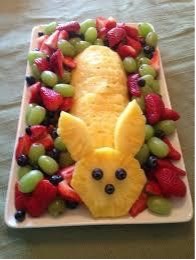Snacks and Party Food
Banana Santas
6g carbs per snowman
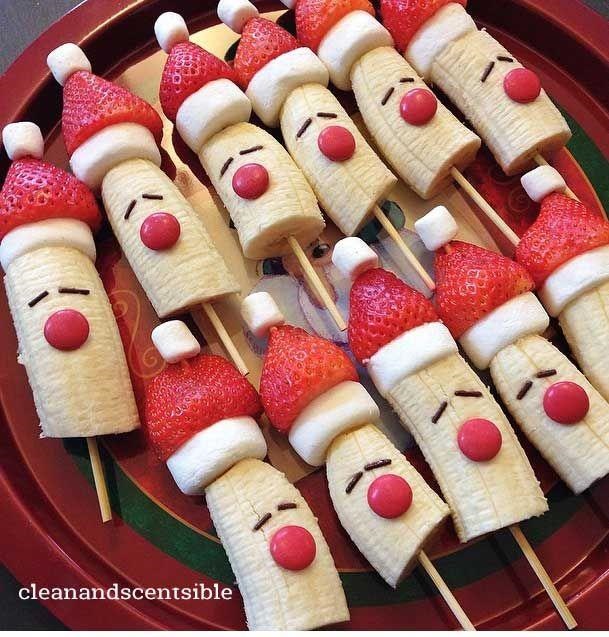
Ingredients
- Bananas - peeled
- Punnet of strawberries
- Wooden skewers
- Edible decorations for face
Method
- Cut the bananas into two or three depending on the size. Cut a small disc to act as the fur rim of the hat.
- Cut the wide end of the strawberries to make it flat.
- Arrange on a skewer as shown in the image above.
- Create face using decorations. TIP: you can swap smarties and chocolates for fruit such as currants.
Apple ‘Candy’ Cane
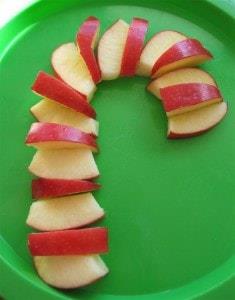
Ingredients
- 1 red apple
Method
- Slice the apple and arrange as shown in the picture.
TIP: Carb count the apple. If it has 10g carbs or less, it can be eaten as a snack.
Strawberry Santas
Three santas = 5g of carbs
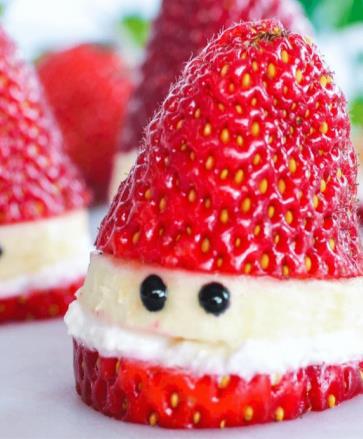
Ingredients
- A few strawberries
- One banana
- Cream cheese -such as ricotta
Method
- Slice the fruit and arrange as shown in the picture above.
Veggie and Fruit Christmas Trees
Vegetable trees = carb free | Fruit trees = carb count your portion

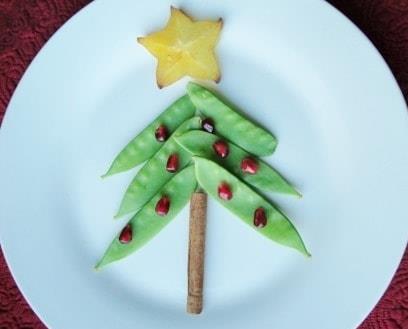
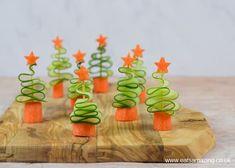
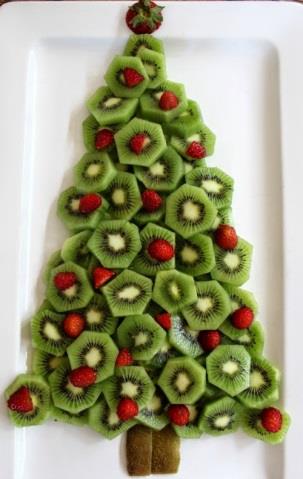
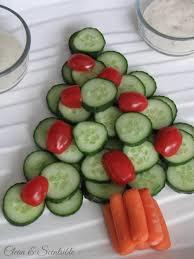
Fruity Snowmen
5g of carbs per snowman
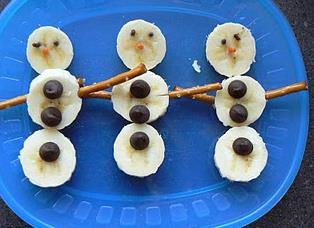
Ingredients
- One banana
- A few blueberries
- Stick pretzels or twiglets
Method
- Cut the bananas into discs and arrange them as shown in the picture above.
- Decorate with the fruit and pretzels.
- Carb count the fruit and pretzels.
Orangey Reindeers
5g carbs
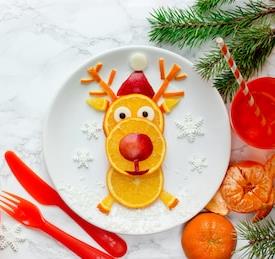
Ingredients
- One orange
- Skin from one apple
- Currants for eyes
Method
- Slice the orange into thin discs and arrange as shown in the picture above.
- Using small pieces of orange strips from the orange rind and the apple skin, decorate as shown in the picture above.
Babybel Reindeer
7g carbs per reindeer

Ingredients
- Babybel Cheese (0g)
- Two pretzels (7g)
- Pomegranate seed or small piece of red pepper for the nose (0g)
- Currants for the eyes
Method
- Make as shown in the picture above.
Penguin Porridge
80g cooked porridge = 10g carbs | 20g blueberries = 2g carbs
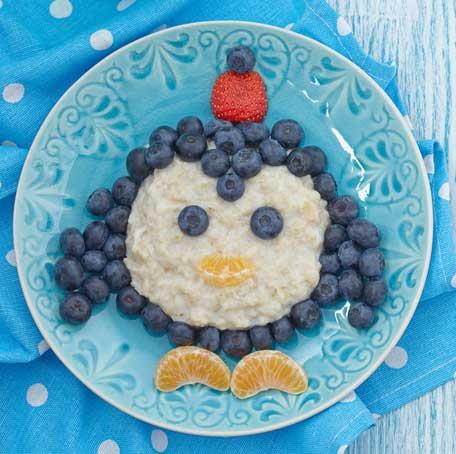
Ingredients
- Oats (10g)
- Semi-skimmed milk
- Blueberries
- Two tangerine segments
- strawberry (cut in half lengthways)
Method
- Make porridge as you normally would.
- Arrange fruit as shown in the picture above.
TIP: this will warm you up on those cold winter mornings!
Santa Belts
Carb free
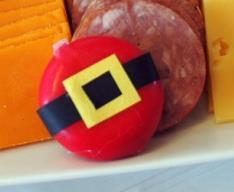
Ingredients
- Pack of babybel edam cheese
- Black and yellow paper
Method
- Cut strips of black paper for Santa's belt and cut buckles out of the yellow paper.
Cheesy Snowmen
Carb free

Ingredients
- Pack of cheese strings
Method
- Simply decorate like snowmen!
Chocolate Orange Bites
5g carbs per five segments
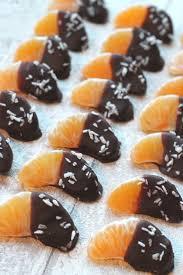
Ingredients
- Satsumas, mandarins or clementines
- 70% dark chocolate
- Unsweetened desiccated coconut (optional)
Method
- Peel and segment the citrus fruit
- Melt the chocolate in a bowl over a pan of boiling water
- Dip the segment in the chocolate until it is half covered
- If you are using coconut, sprinkle over the chocolate before it sets
- Allow to cool and set
Chocolate Mousse (makes four pots)
16g ÷ 4 = 4g carbs per pot
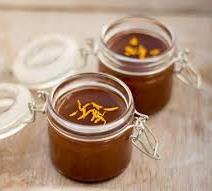
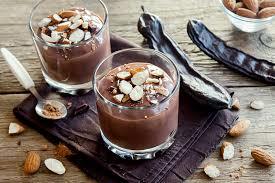
Ingredients
- 50g cocoa powder (0g)
- Two ripe avocados (6g)
- 20g xylitol (10g)
- Two teaspoons of vanilla extract* (0g)
Method
- Scoop the avocado into a blender and add the cocoa powder and vanilla extract.
- Melt the xylitol into liquid form and add to the blender.
- Blend until smooth and serve into four small pots or glasses.
*TIP: Alternatives instead of vanilla extract:
- Add orange zest from one/two oranges (0g) and then decorate with orange peel and zest.
- Or add ¼ teaspoon peppermint extract (0g) and decorate with a couple of fresh mint leaves.
- Or sprinkle with toasted chopped nuts or cinnamon powder for a real Christmas flavour.
- All mousses can be served with fresh berries or clementine segments.
Chocolate Truffles (makes 12)
3g carbs per truffle
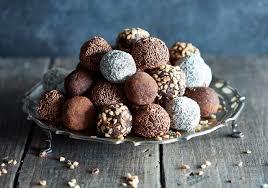
Ingredients
- 100g 70% Lindt dark chocolate (34g)
- 150ml double or whipping cream (0g)
- 50g unsweetened cocoa powder/chopped nuts/desiccated coconut (for rolling your truffles in at the end) (0g)
Method
- Heat the cream (do not boil). Take off the heat and add chocolate to melt into the warm cream.
- Place in a bowl and place in the fridge until firm. Use a teaspoon to scoop 12 walnut-sized truffles. Roll the truffles into a bowl and then add a coating of your choice.
- If you are using chopped nuts and/or coconut to coat your truffles, toast them gently in a dry frying pan to give a fuller flavour. They do not take long to toast so keep them moving and don’t leave the pan or they will burn quickly.
- Once coated, refrigerate to keep the truffles firm and to keep the cream fresh.
TIP: Alternatives:
- You could push a whole hazelnut or almond into the centre of the truffle (0g carbs). Then roll in the coating of your choice.
- Add orange zest from one orange or ¼ teaspoon peppermint extract at step 1) for orange chocolate or mint chocolate truffles. Then roll in the coating of your choice.
- You can add a large pinch of cinnamon powder or mixed spice to the cocoa powder for a real Christmas flavour!
Table Centrepiece - edible wreaths
Carb Free

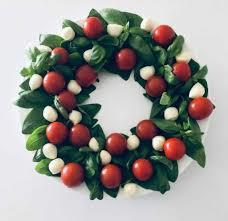
Ingredients
- Cherry tomatoes
- Mini mozzarella balls
- Olives
- Basil leaves
- Rosemary sprigs (decoration only)
Method
- Arrange ingredients in a wreath shape as shown in the pictures above.
Creamy Cheese Snowmen
Snowmen = carb-free | Carb count the crackers

Ingredients
- Low fat cream cheese (can use flavoured cream cheese or goats cheese or ricotta or a mixture)
Method
- Mould your cheese into different sized balls as shown in the picture above.
- Decorate with currants or vegetables.
- Serve with vegetable sticks and/or crackers.
Veggie Bites
Carb free
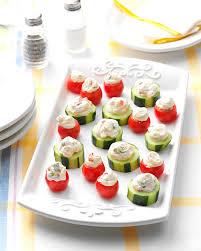
Ingredients
- Cucumber
- Cherry tomatoes
- Cream Cheese
Method
- Cut the top of the tomatoes off and scoop out the seeds.
- Peel the cucumber with stripes (see picture above). Cut the cucumber into chunks and scoop out the middle/seeds.
- Fill with cream cheese mixture.
To download a printable PDF version of the Christmas snacks and party food listed above, please click here.
The Diabetes Team would like our patients to enjoy Diwali, joining in the celebrations with their family and enjoying their food.
It can be difficult for people with diabetes to fully enjoy the Diwali celebrations as many of the traditional desserts are high in sugar which cause blood glucose (BG) levels to rise to high levels very quickly. Even when insulin is given, it doesn't always bring BG levels down.
The traditional desserts are difficult to make healthier. We have tried to give you some ideas for some healthier desserts for the whole family to try, the carbs you need to count are in brackets. Send us your Diwali recipes and pictures we can share them on our app.
Please check your BG 2 hours after these dishes especially if you know your BG rises with certain foods
Cardamom Cookies
Ingredients (25 cookies):
- 200g plain flour (gluten free flour can also be used) (170g)
- 50g ground almonds (0g)
- 30g xylitol (15g)
- ½teaspoon green cardamom powder (0g)
- Pinch of salt (0g)
- ½ teaspoon baking powder (0g)
- 1 egg (0g)
- 60g coconut oil or butter, melted (0g)
- Cashew/pistachio nuts to garnish (0g)
170 + 15 = 185g carbs 185 ÷ 25 = 7.4g
7g carbs per cookie
Method:
- Preheat your oven to 200°C
- Sift the flour, baking powder and spices into a bowl
- Add a pinch of salt, the ground almonds and xylitol and stir in
- Add the egg and the melted butter or coconut oil and mix to form a dough
- Leave to chill in the fridge for at least 30mins
- Roll out so the dough is about the thickness of a pound coin and cut into discs using a cookie cutter. You should get about 25 cookies
- Add a cashew or pistachio nut to the middle of the cookie and bake in the oven until golden
- Remove and allow to cool
Squash Halwa
Ingredients (20 squares):
- 450g/1lb pumpkin or squash (36g)
- 568ml/1 pint milk (27g)
- 1 teaspoon cardamom seeds, crushed (0g)
- 30g clarified butter (0g)
- 30g xylitol (15g)
- 45g halved cashew nuts, almonds or pistachios, lightly toasted (0g)
- 1 teaspoon rosewater (0g)
Method:
- Trim, peel and finely grate the squash or pumpkin
- Combine them with milk, cardamom in a large non-stick frying pan.
- Heat gently and bring to a simmer, stirring occasionally.
- Cook until the squash is tender and almost all the liquid has evaporated, stirring frequently as the mixture thickens.
- Add butter, xylitol, nuts, and rosewater (if using), and stir well.
- Spread the halwa out in a shallow pan to cool; garnish with the cashews
- When cool, cut into squares and serve.
36 + 27 + 15 = 78g carbs 78g ÷ 20 = 3.9g
4g carbs per square
Note: maybe more if you do not get 20 portions
Raspberry and rosewater fool
Ingredients (serves 6):
- 400g raspberries (20g), plus 18 raspberries for decorating. Frozen raspberries can be used • 30g xylitol (15g)
- squeeze lemon juice (0g)
- 300ml double cream (0g)
- 100ml low fat Greek yoghurt (5g)
- 1-2 tablespoons rosewater, or to taste (0g)
- 30g–50g toasted coconut flakes, to decorate (0g)
Method:
- Put the raspberries and xylitol in a saucepan and add the lemon juice. Press the berries lightly with the back of a fork. Cook over a medium heat for 10–15 minutes, or until the mixture thickens, then remove from the heat and set aside to cool completely.
- Meanwhile, put the cream in a bowl and whisk to soft peaks. Add the yoghurt and rose water to taste (be careful as rose water varies considerably) and fold together gently. Pour in the cooled raspberry mixture and ripple through
- Spoon the mixture into six pots and leave to chill in the fridge for at least 1 hour.
- Top with extra raspberries, toasted coconut flakes and serve.
20 + 15 + 5 = 50g carbs 50g ÷ 6 = 8.3
8g carbs per portion
Chocolate Cardamom Truffles
Ingredients (makes 30):
- 200g 70% dark chocolate (64g)
- 300ml double cream (0g)
- 50g butter (0g)
- 30g xylitol (15g)
- ½ - 1 teaspoon cardamom (powdered or crushed seeds)
- Sesame seeds or unsweetened desiccated coconut, or chopped pistachio nuts, toasted to roll the truffles in
Method:
- Whip the double cream until quite stiff
- In a separate bowl, melt the butter, chocolate, xylitol and cardamom
- Fold the cream and the chocolate sauce
- Cool until the mixture ‘sets’
- Use a teaspoon to scoop some of the mixture and roll into a ball
- Coat with the sesame seeds, coconut or pistachio’s
64 + 15 = 79g carbs 79g ÷ 30 = 2.6g
3g carbs per truffle
Rice Kheer
Ingredients(serves 5):
- 50g raw basmati rice (42g)
- 1l milk (50g)
- 20g xylitol (10g)
- 2 -3 cardamom pods (0g)
- Kewra essence (optional) (0g)
- Nuts and or coconut flakes (0g)
Method:
- Wash the rice under running cold water. Soak in plenty of cold water for 30 mins
- Toast your nuts and/or coconut in a warm pan until golden brown. Set aside until the end
- Drain the rice and then crush the grains with your hands
- Add the rice, xylitol, and cardamom pods in a heavy based saucepan and add the milk
- Bring to the boil on a medium heat, stirring often so the milk does not burn on the bottom of the pan.
- Simmer and stir until the rice is tender and the pudding has thickened.
- Remove the cardamom pods and add the kewra essence (if using)
- Scatter your toasted nuts and/or coconut on the top of the pudding before serving
42 + 50 + 10 = 102g carbs 102g ÷ 5 = 20.4g
20g carbs per portion
You can make this healthier using a lower fat milk (the carbs will be the same) or a plant based milk, eg oat milk (70g carbs) or almond milk (30g carbs)
Popular Flavourings for kheer:
❖ Cardamom, cinnamon or nutmeg
❖ Rose Water: a splash of rose water goes a long way in giving the kheer that flowery aroma.
❖ Saffron: can be expensive but if you are making kheer for a special occasion then saffron gives a nice colour and aroma.
❖ Nuts: cashews, almonds, pistachios
❖ Kewra essence: is an extract distilled from pandanus flowers and used to flavour lot of Indian dishes and desserts.
Desserts that are best avoided:
- Jaggery
- Jalebi
- Gulab Jamen
- Ladoo
- Barfi
Try instead:
1) Sugar free jelly and cream (not whipped cream as this contains sugar) 0g carbs
2) Sugar free ice lollies – simply make up your favourite sugar free cordial, pour into lolly moulds and freeze 0g carbs
3) Fruity Choc Pops
Fruity Choc Pops
- 100g 70% dark chocolate (32g)
- Fruit of your choice chopped into bite sized pieces
- Chopped nuts (toasted in the oven for a few minutes) – optional (0g)
- Lolly sticks
Method:
- Toast the nuts and lay over greaseproof paper
- Melt the chocolate and place a dessertspoon of melted chocolate onto the toasted nuts – you should get 6 ‘pops’. Insert your lolly stick
- Place your fruit on top of the soft chocolate
- Place in fridge to firm
- Peel off the greaseproof paper and serve
10g carbs per fruit pop
Fruity Bunny
1 pineapple – peeled and sliced
Fresh fruit
Arrange as shown in the picture
Carb count your portion
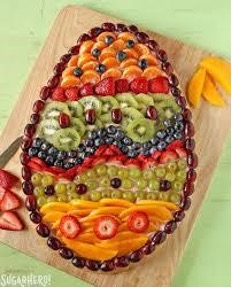
Fruity egg
Selection of fruit of your choice
Arrange in an Easter egg pattern

Spring flowers
- Assorted mini peppers
- Spring onions
- 1 tablespoon low fat cream cheese
- 1 tablespoon plain yoghurt
- chives
Method:
- Mix the yoghurt and cream cheese together and sprinkle with the chives
- Cut the peppers as shown and arrange with the spring onions to make ‘flowers’

Easter bunnies and chicks
- Eggs
- Carrots (for beaks and noses)
- Chives (for the whiskers)
Method:
Hard boil the eggs and assemble as shown in the picture
0g carbs

Spring chicks
- 6 eggs
- 1 tablespoon low fat mayonnaise
- Peppercorns (for the eyes)
- Carrot or peppers (for the beak)
Method:
- Hard boil the eggs
- Slice 2/3 of the way up the egg
- Scoop out the yolk and mash with the mayonnaise
- Assemble the ‘chicks’ as shown
0g carbs
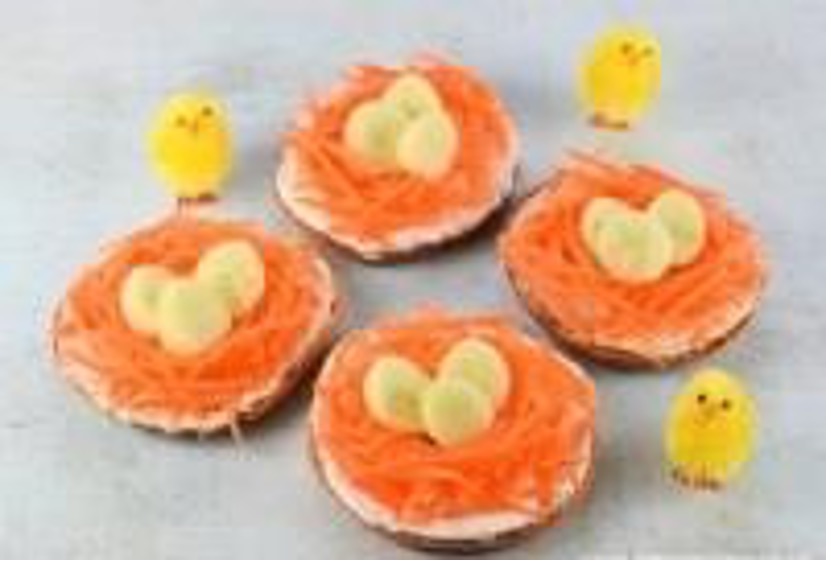
Easter nest bagels
- Bagel, halved
- Carrot, grated
- Cream cheese or houmous
- ½ Cucumber – peeled and made into egg shapes
Method:
- Toast the bagel, spread with cream cheese or houmous and top with the grated carrot to create a ‘nest’.
- Pop the cucumber ‘eggs’ in the middle
Carb count the bagel

More cheeky chicks
- 6 eggs
- Red, yellow or orange peppers or carrot
- Peppercorns for the eyes
Method:
- Hard boil the eggs and assemble as shown in the picture

Carrot pots
- Carrots
- 15g Houmous or low-fat cream cheese
Method:
- Chop the carrots into sticks
- Fill with the houmous or cream cheese
- Arrange as shown in the picture
0g carbs

Two little chicks
- Circular crackers of your choice
- Cheese slices
- Carrot and spinach
Method:
- Assemble as shown
Carb count the crackers
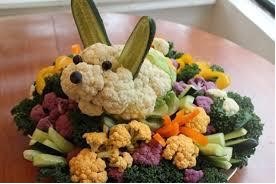
Easter veggie crudities
Selection of vegetables as shown in the picture
Assemble as shown
0g carbs
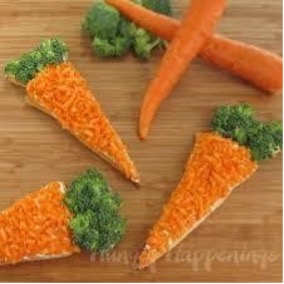
Carrot sandwiches
- Bread or pittas
- Grated carrot
- Grated red Leicester cheese
- Broccoli florets
- Spread or houmous
Method:
- Cut your bread into carrot shapes
- Grate your cheese and/or carrots
- Assemble as shown in the picture
Carb count the bread
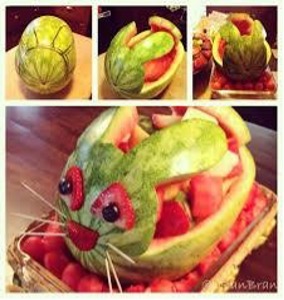
Bunny centrepiece
- One watermelon
- Fruit of your choice
Method:
- Cut as shown in the picture
- Cut the scooped out flesh into bitesized chunks. Mix with other fruit you are adding
- Put the chopped fruit back in the bunny centre piece and serve
Carb count your portion of fruit

Chocolate truffles
(makes 12)
- 100g 70% Lindt dark chocolate (34g)
- 150ml double or whipping cream (0g)
- 50g unsweetened cocoa powder/chopped nuts/desiccated coconut (for rolling your truffles in at the end) (0g)
- Heat the cream (do not boil). Take off the heat and add chocolate to melt into the warm cream.
- Place in a bowl and place in the fridge until firm. Use a teaspoon to scoop 12 walnut sized truffles. Roll the truffles into a bowl and then a coating of your choice
- If you are using chopped nuts and/or coconut to coat your truffles, toast them gently in a dry frying pan to give a fuller flavour. They do not take long to toast so keep them moving and don’t leave the pan or they will burn quickly.
- Once coated, refrigerate to keep the truffles firm (and to keep the cream fresh)
Alternatives:
• You could push a whole hazelnut or almond into the centre of the truffle (0g carbs). Roll in coating as above
• Add orange zest from 1 orange or ¼ teaspoon peppermint extract at point 1) for orange chocolate or mint chocolate truffles. Roll in coating of your choice
• You can add a large pinch of cinnamon powder or mixed spice to the cocoa powder to give a Christmassy flavour
3g carbs per truffle
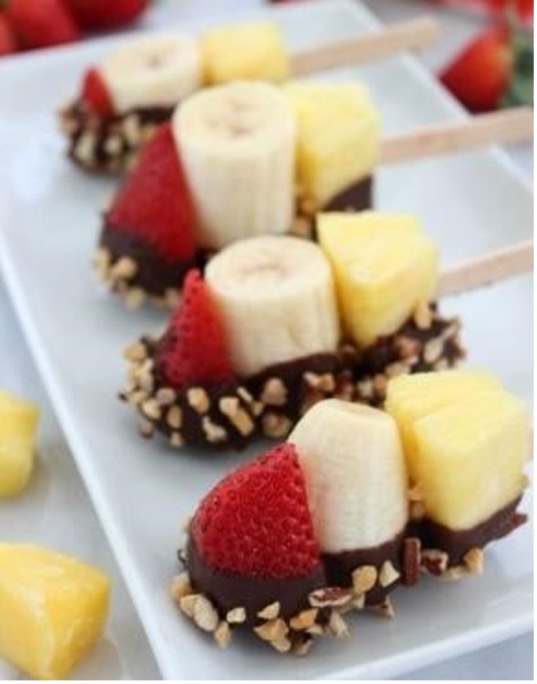
Fruity choc pops
- 100g 70% dark chocolate (32g)
- Fruit of your choice chopped into bite sized pieces
- Chopped nuts (toasted in the oven for a few minutes) – optional (0g)
- Lolly sticks
Method:
- Toast the nuts and lay over greaseproof paper
- Melt the chocolate and place a dessertspoon of melted chocolate onto the toasted nuts – you should get 6 ‘pops’. Insert your lolly stick
- Place your fruit on top of the soft chocolate
- Place in fridge to firm
- Peel off the greaseproof paper and serve
10g carbs per fruit pop
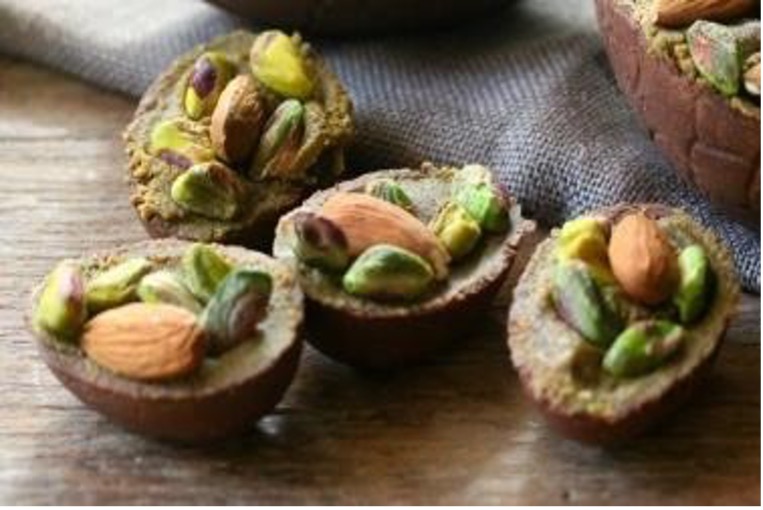
Nut and chocolate indulgence eggs
- 50g 70% dark chocolate (16g)
- ½ tub double cream (0g)
- 1-2 teaspoons cocoa powder (0g)
- ½ teaspoon xylitol (0g)
- ¼ teaspoon vanilla extract (optional )(0g)
- Handful of almonds and pistachios, roasted for a few minutes to give better flavour (0g)
Method:
- Whip the cream until stiff, then add the cocoa powder and vanilla extract.
- Melt the xylitol into liquid form and fold gently into the chocolate cream
- Melt the chocolate bar and pour a thin layer in to an egg shaped mould – allow to cool
- Put a teaspoon of the chocolate mousse mixture into the egg mould and flatten with the back of a knife
- Top with the toasted nuts
- Place in fridge to firm up
- Remove from the mould and serve.
3g carbs per mould
It can be difficult for people with diabetes to fully enjoy their Eid celebrations as many of the traditional desserts are high in sugar which causes blood glucose (BG) levels to rise to high levels very quickly. Even when insulin is given, it doesn't always bring BG levels down.
The Diabetes Team would like our patients to enjoy Eid, joining in the celebrations with their family and enjoying their food.
The traditional desserts like Jalebi, Gulab Jamen and Barfi are difficult to make healthier. We have tried to give you some ideas for some healthier desserts for the whole family to try, the carbs you need to count are in brackets.
Please check your BG two hours after these dishes, especially if you know your BG rises with certain foods.

Cardamom Cookies (makes 25 cookies)
170 + 15 = 185g carbs, 185 ÷ 25 = 7.4g = 7g carbs per cookie
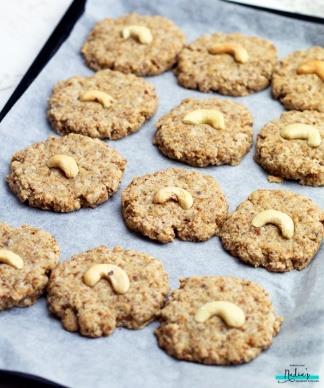
Ingredients
- 200g plain flour (gluten-free flour can also be used) (170g)
- 50g ground almonds (0g)
- 30g xylitol (15g)
- ½ teaspoon green cardamom powder (0g)
- Pinch of salt (0g)
- ½ teaspoon baking powder (0g)
- One egg (0g)
- 60g coconut oil or butter, melted (0g)
- Cashew or pistachio nuts to garnish (0g)
Method
- Preheat your oven to 200°C
- Sift the flour, baking powder and spices into a bowl.
- Add a pinch of salt, the ground almonds and xylitol and stir in.
- Add the egg and the melted butter or coconut oil and mix to form a dough
- Leave to chill in the fridge for at least 30 minutes.
- Roll out so the dough is about the thickness of a pound coin and cut into discs using a cookie cutter. You should get about 25 cookies.
- Add a cashew or pistachio nut to the middle of the cookie and bake in the oven until golden.
- Remove and allow to cool.
Seviyan Kheer (serves six)
114 + 40 + 15 = 169g carbs, 169 ÷ 6 = 17.1g = 28g carbs per portion
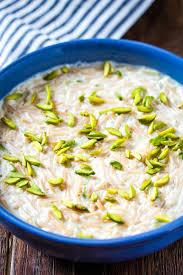
Ingredients
- 150g raw vermicelli (114g)
- Three cloves or one cinnamon stick (whichever flavour you prefer) (0g)
- 800ml milk (40g)
- Three teaspoons rosewater (0g)
- 50g butter (0g)
- Two to three green cardamom pods, seeds crushed (0g)
- 30g xylitol (15g)
Method
- Fry the vermicelli in the butter until golden brown. Set aside.
- Boil the milk with the spices and the xylitol. Once it has come to the boil, turn down the heat and simmer for 5-10 mins.
- Remove the cloves or cinnamon stick and discard.
- Add the vermicelli and simmer until thickened.
Tahini stuffed dates with chocolate cardamom sauce
150 + 34 = 184g carbs, 184g ÷ 10 = 18.4g = 18g carbs per date
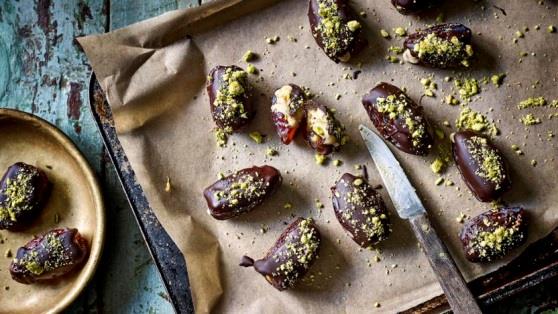
Ingredients
- 20g tablespoons light tahini (0g)
- 10 medjool dates, pitted (150g)
- 100g 70% dark chocolate, broken into pieces (34g)
- ½ teaspoon ground cardamom (0g)
- Two tbsp chopped pistachio nuts (0g)
Method
- Spoon a small amount of the tahini into the middle of each date. Place on a baking sheet or freezer-proof board and chill in the freezer until the tahini is firm and set.
- Meanwhile, melt the chocolate in a heatproof bowl set over a saucepan of gently simmering water (do not allow the bottom of the bowl to touch the water). Stir the ground cardamom into the melted chocolate.
- Transfer the dates to serving plates and pour over the chocolate mixture. Sprinkle with the pistachio nuts and serve immediately.
Squash Halwa
36 + 27 + 15 = 78g carbs, 78g ÷ 20 = 3.9g = 4g carbs per square. TIP: maybe more if you do not get 20 portions.
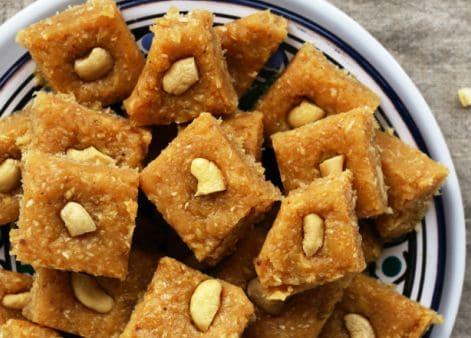
Ingredients
- 450g/1lb pumpkin or squash (36g)
- 568ml/1 pint of milk (27g)
- One teaspoon cardamom seeds, crushed (0g)
- 30g clarified butter (0g)
- 30g xylitol (15g
- 45g halved cashew nuts, almonds or pistachios, lightly toasted (0g)
- One teaspoon rosewater (0g)
Method
- Trim, peel and finely grate the squash or pumpkin.
- Combine them with milk, cardamom in a large non-stick frying pan.
- Heat gently and bring to a simmer, stirring occasionally.
- Cook until the squash is tender and almost all the liquid has evaporated, stirring frequently as the mixture thickens.
- Add butter, xylitol, nuts, and rosewater (if using), and stir well.
- Spread the halwa out in a shallow pan to cool; garnish with the cashews.
- When cool, cut into squares and serve.
Raspberry and Rosewater Fool (serves six)
20 + 15 + 5 = 50g carbs, 50g ÷ 6 = 8.3 = 8g carbs per portion
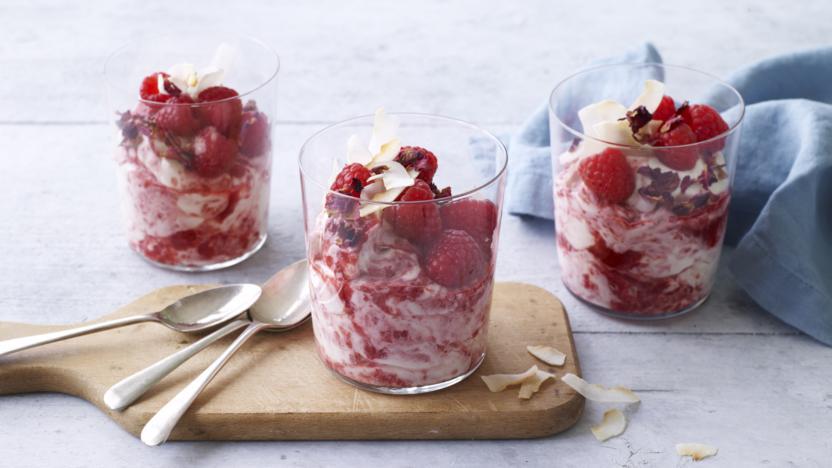
Ingredients
- 400g raspberries (20g), plus 18 raspberries for decorating. Frozen raspberries can be used
- 30g xylitol (15g)
- squeeze lemon juice (0g)
- 300ml double cream (0g)
- 100ml low fat Greek yoghurt (5g)
- One to two tablespoons rosewater, or to taste (0g)
- 30–50g toasted coconut flakes, to decorate (0g)
Method
- Put the raspberries and xylitol in a saucepan and add the lemon juice. Press the berries lightly with the back of a fork. Cook over medium heat for 10–15 minutes, or until the mixture thickens, then remove from the heat and set aside to cool completely.
- Meanwhile, put the cream in a bowl and whisk to soft peaks. Add the yoghurt and rose water to taste (be careful as rose water varies considerably) and fold together gently. Pour in the cooled raspberry mixture and ripple through.
- Spoon the mixture into six pots and leave to chill in the fridge for at least one hour.
- Top with extra raspberries, toasted coconut flakes and serve.
Fruity Fattoush (serves eight)
70 + 24 + 13 + 12 + 30 + 18 + 11 + 8 = 186g carbs, 186g ÷ 8 = 23.25g = 23g carbs per portion.
TIP: If you want to use other fruit, remember to carb count. You can use gluten-free wraps too.
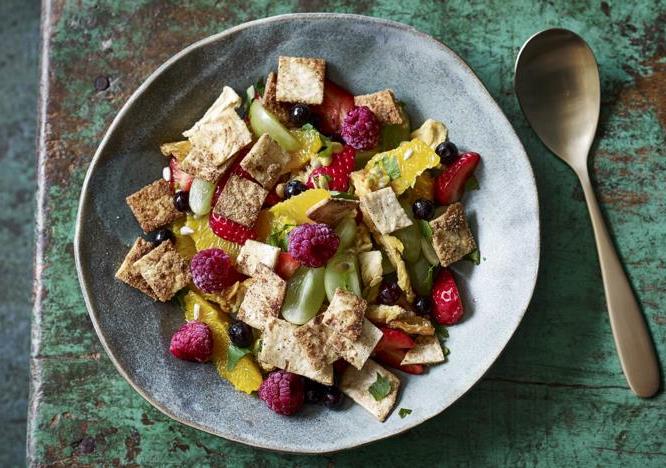
Ingredients
For the crispy tortillas:
- Four small or two large flour tortilla wraps, cut into 1cm or ½ inch pieces (70g)
- 10g spread, melted or spray oil (0g)
- ½ teaspoon ground cinnamon (0g)
For the fruit salad:
- 400g fresh strawberries, hulled and quartered (24g)
- One large orange, peeled and segmented (13g)
- 120g fresh pineapple (12g)
- 200g green grapes, halved lengthways (30g)
- 200g frozen blueberries (18g
- 150g frozen raspberries (11g)
- Two passion fruit, halved and pulp spooned out (8g)
- Two tablespoons sunflower seeds or pumpkin seeds (0g)
- 25g mint, roughly chopped (0g)
Method
- Begin by making the crispy tortillas. Preheat the oven to 200°C/180°C Fan/Gas 6. Put the tortilla pieces in a large baking tray in a single layer. Pour over the melted spread or spray with oil, then, using your hands, toss the tortillas around so that each piece is coated.
- Sprinkle over the cinnamon and make sure the pieces are coated well.
- Transfer the tortillas to the oven and bake until crispy. They will not take long – minutes, so keep a close eye on them so that they do not burn. You may need to turn them over partway through.
- You will know they are ready when they make a crunchy sound when dropped onto the tray. Once the tortillas are crisp, leave them on the tray to cool and dry out a little bit more while you put the salad together.
- Put all the salad ingredients into a large bowl and mix together. This can be done just before serving so that the frozen fruit stays frozen.
- Serve in individual bowls and sprinkle the crispy tortillas over the top.
Chocolate Cardamom Truffles (makes 30)
64 + 15 = 79g carbs, 79g ÷ 30 = 2.6g = 3g carbs per truffle
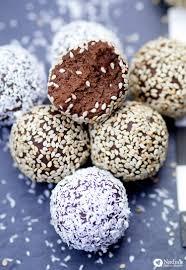
Ingredients
- 200g 70% dark chocolate (64g)
- 300ml double cream (0g)
- 50g butter (0g)
- 30g xylitol (15g)
- ½ - 1 teaspoon cardamom (powdered or crushed seeds)
- Sesame seeds or unsweetened desiccated coconut, or chopped pistachio nuts, toasted to roll the truffles in.
Method
- Whip the double cream until quite stiff.
- In a separate bowl, melt the butter, chocolate, xylitol and cardamom.
- Fold the cream and the chocolate sauce.
- Cool until the mixture ‘sets’.
- Use a teaspoon to scoop some of the mixture and roll into a ball.
- Coat with the sesame seeds, coconut or pistachio’s.
Rice Kheer (serves five)
42 + 50 + 10 = 102g carbs, 102g ÷ 5 = 20.4g = 20g carbs per portion.

TIP: You can make this healthier using lower fat milk (the carbs will be the same) or a plant-based milk, for example, oat milk (70g carbs) or almond milk (30g carbs).
Ingredients
- 50g raw basmati rice (42g)
- 1l milk (50g)
- 20g xylitol (10g)
- Two to three cardamom pods (0g)
- Kewra essence (optional) (0g)
- Nuts and or coconut flakes (0g)
Method
- Wash the rice under running cold water. Soak in plenty of cold water for 30 minutes.
- Toast your buts and/or coconut in a warm pan until golden brown. Set aside to the end.
- Drain the rice and then crush the grains with your hands.
- Add the rice, xylitol, and cardamom pods in a heavy-based saucepan and add the milk.
- Bring to the boil on medium heat, stirring often so the milk does not burn on the bottom of the pan.
- Simmer and stir until the rice is tender and the pudding has thickened.
- Remove the cardamom pods and add the kewra essence (if using).
- Scatter your toasted nuts and/or coconut on the top of the pudding before serving.
NOTE: To make Phirni, this recipe can be used but replace rice with ground rice – the carbs should be the same.
Popular Flavourings for kheer:
- Cardamom, cinnamon or nutmeg
- Rose Water: a splash of rose water goes a long way in giving the kheer that flowery aroma.
- Saffron: can be expensive but if you are making kheer for a special occasion then saffron gives a nice colour and aroma.
- Nuts: cashews, almonds, pistachios
- Kewra essence: is an extract distilled from pandanus flowers and used to flavour a lot of Indian dishes and desserts.
Desserts that are best avoided:
- Jaggery
- Jalebi
- Gulab Jamen
- Ladoo
- Barfi
Try instead:
- Sugar-free jelly and cream (not whipped cream as this contains sugar) - 0g carbs
- Sugar-free ice lollies – simply make up your favourite sugar-free cordial, pour into lolly moulds and freeze - 0g carbs.
- Fruity Choc Pops (see below)
Fruity Choc Pops
10g carbs per fruit pop
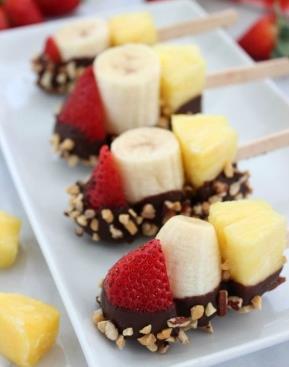
Ingredients
- 100g 70% dark chocolate (32g)
- Fruit of your choice chopped into bite-sized pieces
- Chopped nuts (toasted in the oven for a few minutes) – optional (0g)
- Lolly sticks
Method
- Toast the nuts and layover greaseproof paper.
- Melt the chocolate and place a dessert spoon of melted chocolate onto the toasted nuts – you should get 6 ‘pops’. Insert your lolly stick.
- Place your fruit on top of the soft chocolate.
- Place in fridge to firm.
- Peel off the greaseproof paper and serve.
To download a printable PDF version of these recipes, please click here.
Gulab Jamun
Each Gula Jamun will have 6g carbs
Total carbs - 86g in the recipe. 15 small Gulab Jamun balls = 86÷15 = 5.7g = 6g carbs per gulab jamun ball

Eid al-Fitr is also called ‘Festival of Breaking the Fast’ that marks the end of Ramadan.
Desserts and puddings in Asian cuisine are traditionally very sweet and carbohydrate-based, therefore making it very difficult for people with diabetes to celebrate Eid and enjoy the feast without the risk of raising their blood glucose to a high level.
One ball of Gulab Jamun usually contains about 54g carbs. We wanted to include a well-loved recipe containing less sugar that everyone can enjoy.
This recipe uses xylitol instead of sugar. Xylitol is a carbohydrate known as a ‘sugar alcohol’ usually processed from natural plant sources. However, xylitol is poorly absorbed by the digestive system and acts as soluble fibre. Because of this, it does not raise blood glucose fast. When you carb count, just count half the carbs in the amount of xylitol used (see recipe below).
If too much xylitol is consumed, it may cause some bloating or a laxative effect. As with all new foods, it’s good for you to understand how it affects your blood glucose (BG). So, if you try this recipe, we would recommend you to test your BG two hours after eating.
Ingredients (Makes 15 small balls)
- 140g ricotta cheese (0g carbs)
- 70g coconut flour (11g)
- 70g ground almonds (don’t need to count nuts)
- ½ teaspoon bicarbonate of soda
- 150g xylitol (50g for the dough and 100g for the syrup (75g)
- 100mls water
- 4 cardamom pods
- Flaked almonds and/or pistachio nuts or desiccated coconut to garnish
- Vegetable oil for frying
Method
- In a bowl, mix together the ricotta cheese, coconut flour, ground almonds, bicarbonate of soda and 50g of the xylitol until a soft dough has formed. Leave to rest for 15mins.
- Meanwhile, make the syrup by mixing 100g xylitol with the water and add the cardamom pods to flavour the syrup. Simmer for 15 mins until the liquid thickens (it thickens more as it cools so make sure you cover your gulab jamuns before the syrup gets too thick)
- Make your gulab jamun balls. Put a tiny amount of oil on your hands to prevent the dough from sticking. Pull a small amount of the dough and roll in your hands until smooth (so they do not fall apart when frying).
- When you have 15 gulab jamun balls, heat your oil on a medium heat
- Fry 2-3 balls at a time, flipping over gently to brown both sides. Place on kitchen tissue when golden brown.
- When they are all cooked, pour over or place in the syrup and leave for 30 mins for the syrup to soak into the gulab jamun balls
- Garnish with chopped nuts or roll in desiccated coconut
To download a printable PDF version of this recipe, please click here.
Squirmy worms

- Pack of plastic straws
- 1 pack of sugar-free jelly
Stand the straws up in a jar as shown in the picture. Make up the sugar free jelly as per instructions on the pack. Pour into the straws and allow to set. Once set slice the straw carefully to release the ‘worms’ into a bowl
0g carbs
Babybel eyeballs
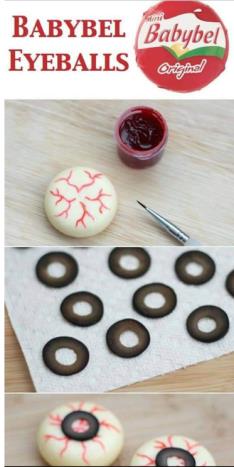
- Pack of Babybels
- 3 pitted black olives
- Red food colouring and a paintbrush
Slice the olives as shown in the picture. Unwrap the Babybel and assemble your ‘eyes’ as shown
0g carbs
Screaming strawberries

- Punnet of strawberries
- White chocolate
- Black food colouring and a paintbrush
Melt the chocolate. Dip in the strawberries. When set, draw on the ‘scream’ face.
8g carbs each
Eggy Spiders
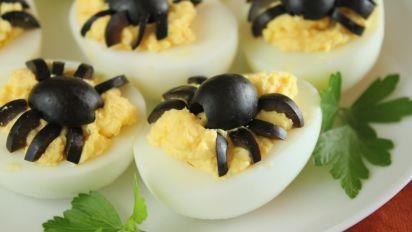
- 6 eggs, 2 black olives per egg
Boil the eggs until hard boiled. Scoop out the yolks into a bowl. Add 1 teaspoon of low fat mayonnaise and mix. Place a spoonful of the yolk mixture in each cavity of the egg white.
Cut an olive in half lengthways. Put half onto the egg for the body and slice the other half into little legs. See picture.
0g carbs
Pumpkin eggs

- 6 eggs
Boil eggs until hard boiled. Cut in half lengthways. Gently scoop out the yolk and replace upside down (so it is raised). Score the egg to look like a pumpkin. Dust with paprika if desired. Add a cutting of spring onion to make the stalk.
0g carbs
Ghosty cheesestrings

Simply draw scary faces on your cheesestring (packet only!)
Stand in container for children to choose
0g carbs
Spaghetti brains
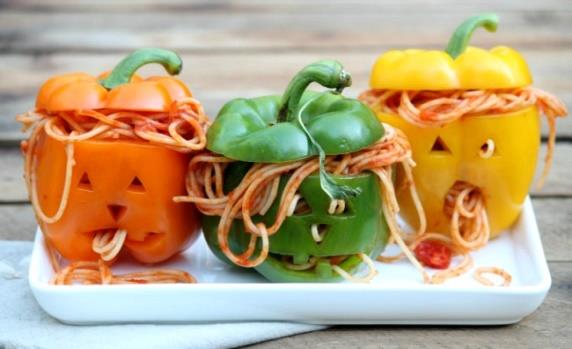
- Peppers
- Spaghetti
- Red pesto
Cook spaghetti as per instructions on the pack. Cut pumpkin faces in the peppers as shown in the picture.
Once the spaghetti is cooked, carb count your portion. Mix 1 tablespoon of red pesto in and then fill your pepper as shown
Carbs will depend on your portion
Satsuma pumpkins
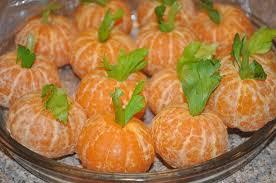
Carb count if more than 2 eaten
Apple Mummies
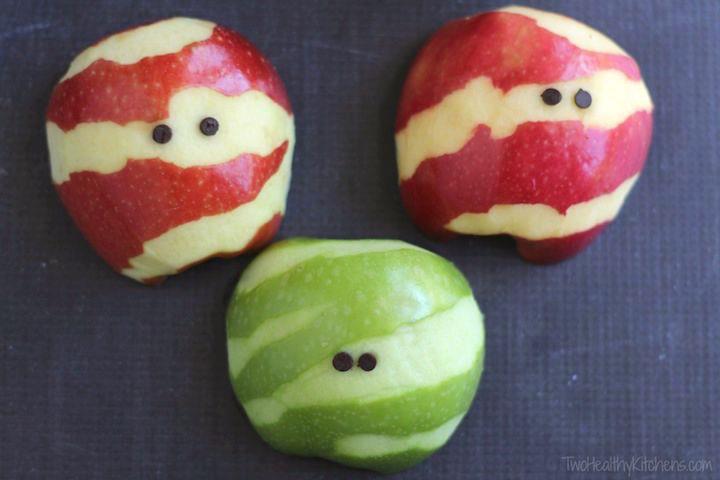
Peel the skin from the apple similar to the picture. Could use cocoa nibs for the eyes
Carb count if apples are large
Kiwi Frankensteins
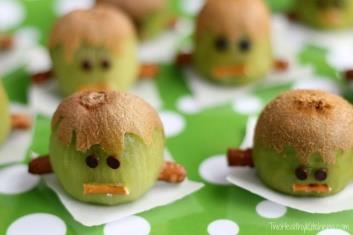
- 2 kiwi fruit (serves 4)
- Cucumber, red pepper or other firm veg that will act as the ‘bolts’ in frankenstein’s head!
- Cut the kiwi fruit in half, leaving skin on
- Peel the skin leaving enough for the hair (see picture)
- Decorate faces (could use cocoa nibs, orange peel, peppers
4.5g carbs per 1 kiwi
Apple monster mouths

- One apple, sliced
- No sugar added peanut butter – crunchy or smooth
- Sunflower seeds
Either push the sunflower seeds into the apple (see picture on the left) or glue the apple slices together with ½ teaspoon of peanut butter and push the sunflower seeds in the peanut butter (see picture on the right)
Carb count the apple if large amount eaten
Witches fingers
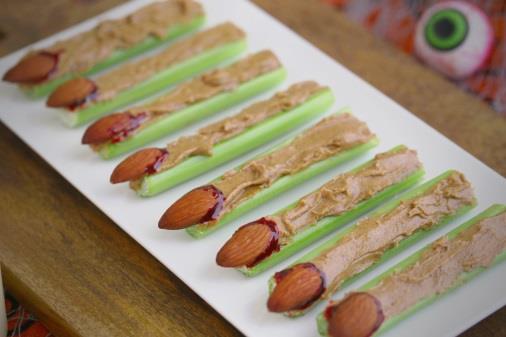
- Beetroot witches hats (50g– boil the beetroot. Cut into discs. Cut out hats as shown - 0g carbs
- Sweet potato pumpkins – (50g – peel the sweet potato. Slice into discs and steam or boil until soft. Cut out faces as shown - 5g carbs per pumpkin
- Parsnip ghosts – (50g -boil the parsnip. Slice into discs using the wide end of the parsnip. Cut into ghosts as shown – 0g carbs
- Celery sticks
- Peanut butter – sugar free
- Whole almonds
Fill the celery sticks with peanut butter. Add an almond for the fingernail.
0g carbs
Spooky roast vegetable bites
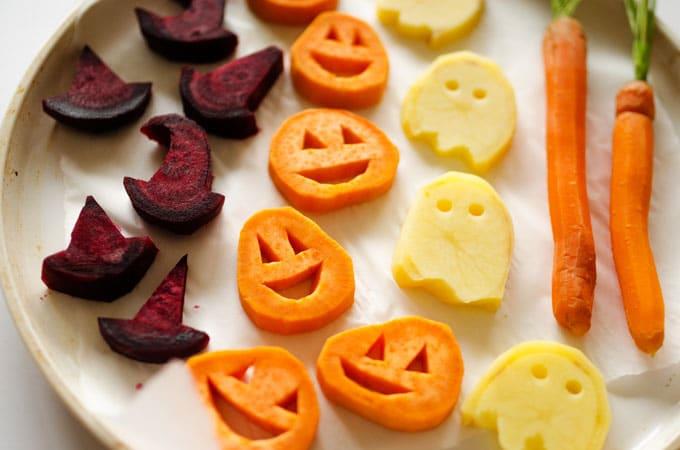
- Beetroot witches hats (50g– boil the beetroot. Cut into discs. Cut out hats as shown - 0g carbs
- Sweet potato pumpkins – (50g – peel the sweet potato. Slice into discs and steam or boil until soft. Cut out faces as shown - 5g carbs per pumpkin
- Parsnip ghosts – (50g -boil the parsnip. Slice into discs using the wide end of the parsnip. Cut into ghosts as shown
0g carbs
Eyeball jelly
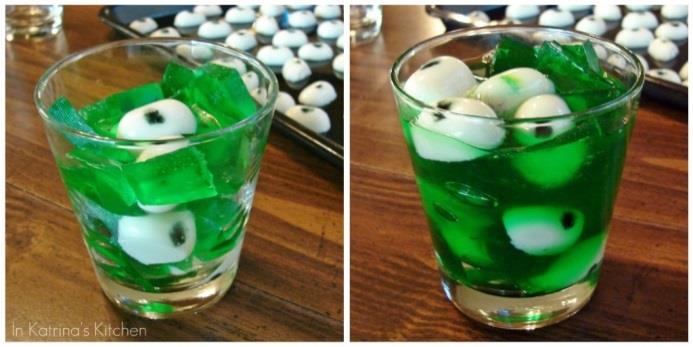
- 1 pack of sugar free jelly (colour of your choice)
- 1 tin of lychees
- Red grapes
- Drain the lychees and rinse under cold water to remove excess syrup
- Insert 1 grape into the cavity of the lychee to make the ‘eyeball’
- Make up the jelly as per instructions on the packet
- Drop the lychee ‘eyeballs’ into the jelly and allow to set.
Carb count for lychees and grapes
Severed fingers
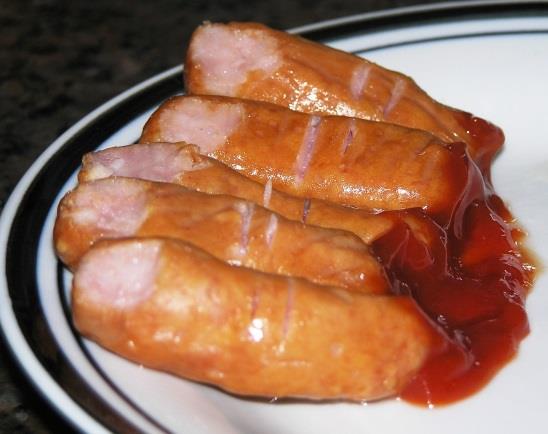
One pack of good quality sausages or chipolatas (high meat content)
1. Grill or oven bake sausages until cooked through. Cut the sausage as per the picture.
2. Check the packet for amount of carbs per sausage/chipolata
1 tablespoon of tomato ketchup is 4g carbs
Parsnip ghosties
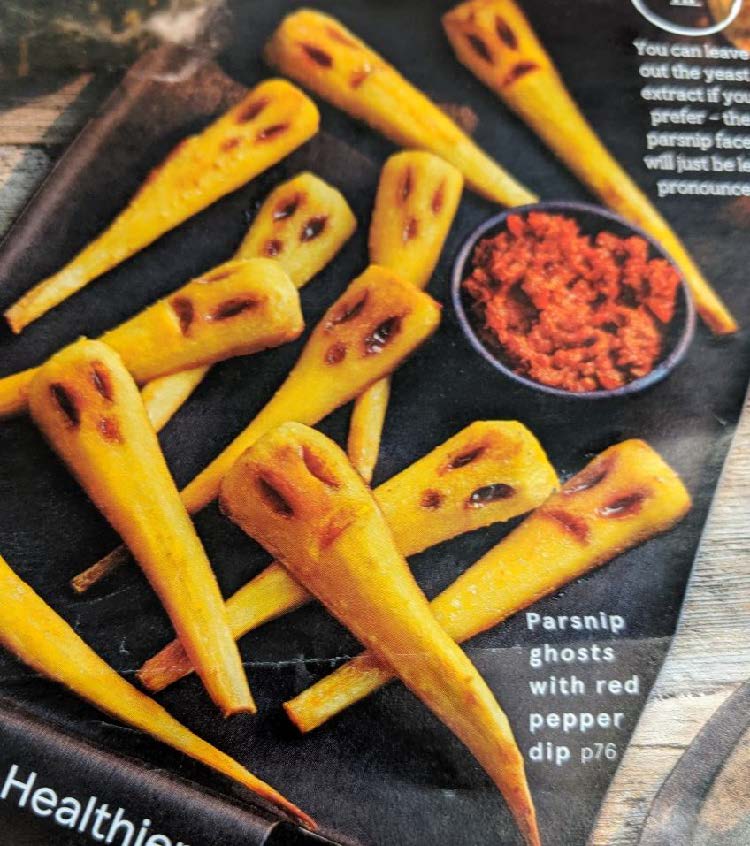
Serves 4
- 200g parsnips (40g carbs). Carbs per portion 40g ÷ 4 = 10g
Method
1. Peel parsnips, slice in half lengthways
2. Parboil for 5 mins, drain and refresh in cold water
3. When cool enough to handle, carve the eyes and mouth into each one.
4. Rub each one with the olive or veg oil
5. Roast in the oven until golden brown and soft.
6. Brush the yeast extract over the faces to highlight the face details
Roasted Pepper Dip (no cook)
• 1 jar of roast pepper, drained (look at carbs on the label and carb count for the amount you use)
• 1 chilli (optional) (0g carbs)
• 15g (1 tablespoon) plain yoghurt (1.2g carbs)
• 1 small clove garlic (crushed or finely grated)(0g carbs)
• 1 teaspoon red or green pesto (0g carbs)
• Salt and pepper to taste
Tip the peppers into a bowl, add the other ingredients and blend with a handblender until smooth
Carbs per portion will depend on carbs in jar of red peppers
Monster eyes
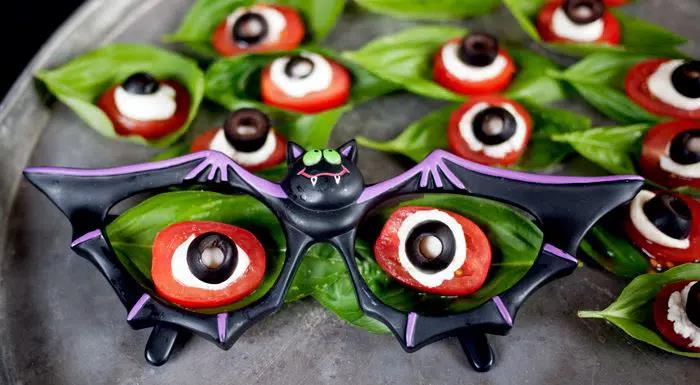
• 1 pack of cherry tomatoes
• 1 pack of cream cheese (any flavour)
• 5-6 destoned black olives, sliced
• Basil leaves
1. Slice the tomatoes in half and lay on top of basil leaf
2. Put ½ teaspoon of cream cheese on the flat side of the tomato
3. Add the slice of olive until you have your monster eyes as shown in the picture
0g carbs
Mummy eyes
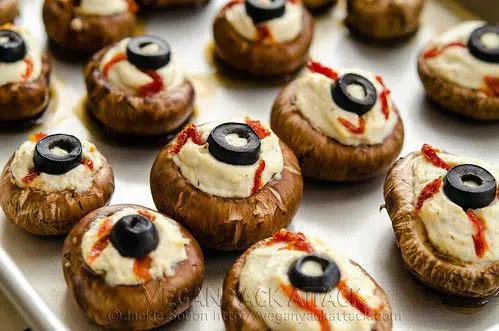
• 1 pack of chestnut mushrooms
• 1 pack of cream cheese (any flavour)
• 24-5 destoned black olives, sliced
• Red peppers, sliced into very thin slivers
1. Clean the mushrooms. Can be eaten cooked or raw for this recipe
2. Put 1 teaspoon of cream cheese on the stalk side of the mushroom
3. Add the olive for a pupil and the thin slices of pepper for veins
0g carbs per ‘eye’
Chewy pumpkin cookies
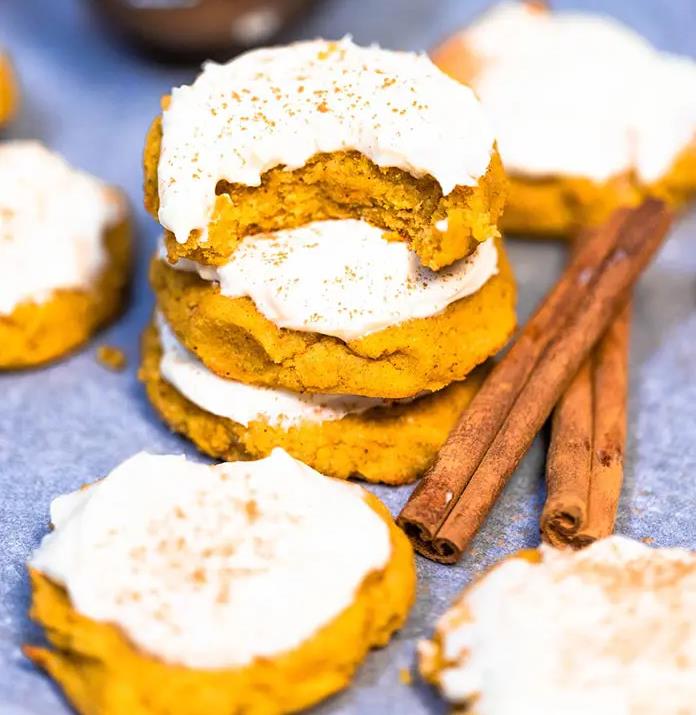
Ingredients: (makes 12 cookies)
• 300g almond flour or ground almonds (0g)
• 50g coconut flour (13g)
• 80g xylitol (40g)
• ½ teaspoon vanilla extract (0g)
• 100g pumpkin (or butternut squash), roasted (8g)
• 1 egg, beaten (0g)
• 1 teaspoon baking powder (0g)
• ½ teaspoon cinnamon (optional) (0g)
• 50g butter or spread, melted and cooled (0g)
• 50g plain yoghurt (0g)
1. Mix the melted butter, beaten egg, vanilla extract, yoghurt and pumpkin puree together
2. Mix the flours, baking powder, xylitol and cinnamon (if using)
3. Mix the wet ingredients with the dry ingredients and mix to form a dough. Rest the dough for 5 mins and then divide into 12 balls and flatten slightly into your desired shape.
4. Bake for 12 – 15 mins in an pre heated oven 180°C
5. Cream cheese frosting – mix 100g mascarpone cheese with 1 teaspoon of cinnamon (optional) and the zest of an orange and decorate when the cookies are cold (0g carbs)
Total carbs in recipe = 13 + 40 + 8 = 61g
Carbs in portion = 61 ÷ 12 = 5g carbs each cookie
Pumpkin chilli stew
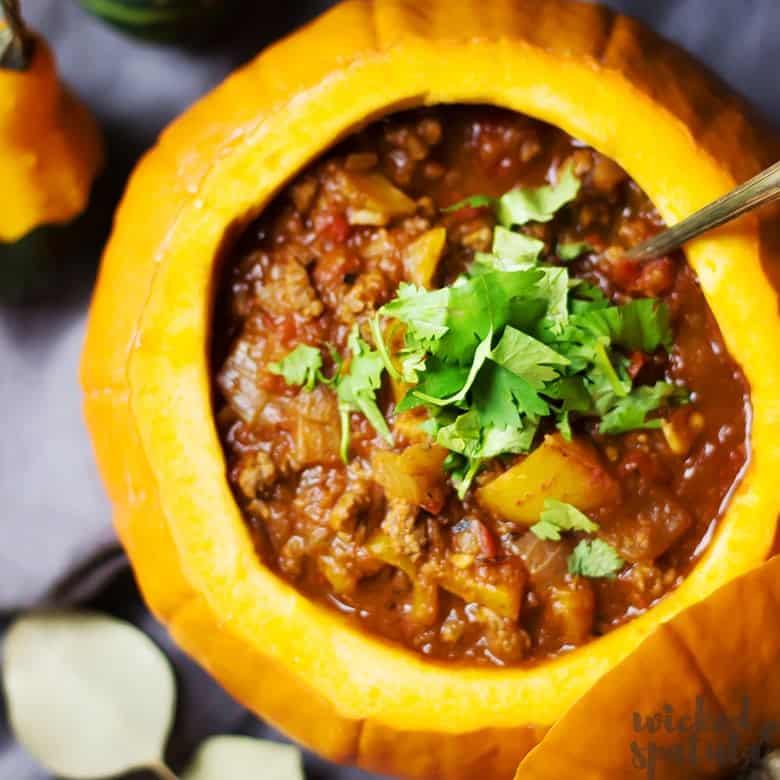
Ingredients: (serves 4)
· 2 tablespoons sunflower oil (0g)
· 1 large onion, diced (0g)
· 3 garlic cloves, finely chopped (0g)
· 1 celery stalk, finely diced (0g)
· 1 teaspoon freshly ground black pepper (0g)
· 1 teaspoon ground turmeric (0g)
· ½ teaspoon ground cinnamon (0g)
· ½ teaspoon ground ginger (0g)
· 100g red lentils or red kidney beans (0g)
· 400g tin chickpeas, drained and rinsed (0g)
· 500ml tomato sauce or passata (0g)
· A good handful of parsley, roughly chopped (0g)
· A large bunch of coriander, roughly chopped (0g)
· 300g squash or pumpkin (25g)
· 1.2 litres vegetable stock (0g)
· 1 bay leaf (0g)
· 50g vermicelli, orzo or other small pasta (20g)
· 1 red chilli or ½ teaspoon chilli powder (or to your spice limit) (0g)
1. Heat the oil in a large saucepan over a medium heat. Add the onions and sauté until just starting to turn golden. Turn the heat down to medium-low and add the garlic, celery, pepper, turmeric, cinnamon and ginger. Sauté for a couple of minutes.
2. Now add the lentils, chickpeas, saffron, tomato sauce or passata, parsley and about half the coriander. Cook over a low heat for 15 minutes.
3. Meanwhile, peel and deseed the squash or pumpkin and cut into large cubes. Add to the pan with the stock and bay leaf. Cover and simmer gently for about 30 minutes. Add the pasta and simmer until it is cooked. Season with salt and pepper to taste.
4. Serve immediately, scattered with the remaining coriander leaves and with a few dates on the side, if you like.
Total carbs in recipe = 25 + 20 = 45g
Carbs in portion = 45 ÷ 4 = 11g carbs
Pumpkin soup
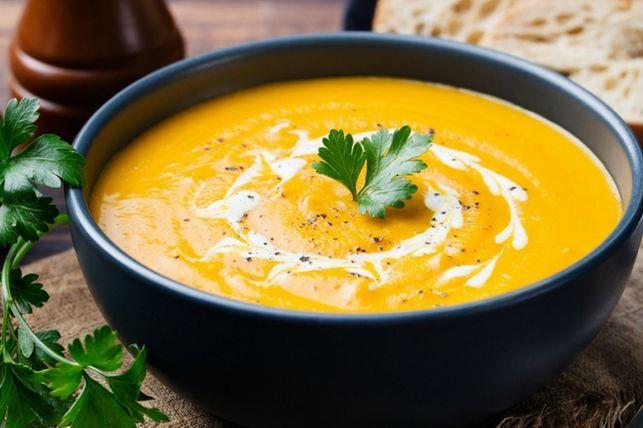
Ingredients:
• 1kg pumpkin, peeled and deseeded (it maybe not suitable to use your carved pumpkin, ensure its an edible one!). Can use 1 medium butternut squash (0g)
• 2 tablespoons oil (0g)
• 1 onion, diced (0g)
• 1 stick of celery, washed and chopped finely (0g)
• 1 carrot, peeled and diced finely (0g)
• 1 garlic clove, thinly sliced (0g)
• 850ml hot vegetable stock (0g)
• 2 tablespoons crème fraîche, (0g)
1. Heat oven to 200°C/180°C fan/gas 6.
2. Cut 1 peeled and deseeded pumpkin/squash into large cubes, about 4cm/1½in across, then toss in a large roasting tin with 1 tablespoon of the oil.
3. Roast for 30 mins, turning once during cooking, until golden and soft.
4. While the pumpkin/squash cooks, heat the oil in a large saucepan, then add the diced onions, celery, carrot and thinly sliced garlic clove (add the chilli or curry powder at this stage of you are using?
5. Cook for about 5 mins , stirring and then add the roasted pumpkin and stir.
6. Add the stock (and canned coconut milk if you are using)
7. Simmer for 20 mins and blend your soup until smooth.
Options:
Can add 1 red chilli or ½ teaspoon chilli powder to make it spicy or add ½ can coconut milk (check carbs) or 1 teaspoon of curry powder to making a curried pumpkin soup. If you use coconut milk, do not use crème fraise as well)
Carbs = 0g (maybe about 5g if using coconut milk)
Petrifying pizza
• Simply decorate your pizza with spiders made from olives (0g carbs) and ghost-shaped mozzarella (0g carbs)
Carb count as you normally would
- Boiled eggs (0g)
- Quorn mini scotch eggs (4g scotch egg)
- Olives, pickled onions etc (0g)
- Sausages (try veggie ones!)(5g each)
Top tips:
Try making sandwiches with your favourite fillings using baguettes, pitta breads flat breads instead of sliced bread (carb count the bread)
Breadsticks (check the pack for the carbs on each breadstick)
Pizza slices (30g per slice)
Cheese and Biscuits (check the pack for the carbs in each cracker)
Salads – bean/lentil salad, Greek Salad, Green Salad (0g)
Potato Salad, Rice salads and Pasta salads (must be carb-counted)
Pastryless pork pie
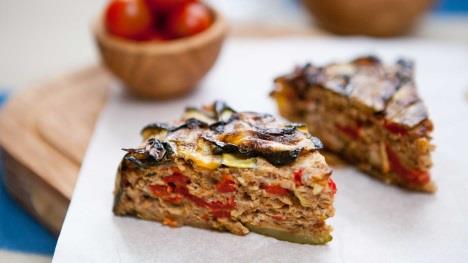
Ingredients (serves 8):
- 4-5 large courgettes (0g)
- 1 tablespoon veg oil (0g)
- 50g dried breadcrumbs (15g)
- 1 red onion, finely chopped (0g)
- 2 garlic cloves, crushed (0g)
- 290g jar red peppers, drained and chopped (0g)
- 500g minced pork (0g)
- 1 egg (0g)
- 1 teaspoon chilli flakes or powder (0g)
- Zest from 1 lemon (0g)
15g ÷ 8 = 1.9g = 2g (not enough to count) = 0g carbs
Method:
1. Drizzle a little oil into an 18cm springform tin and brush all over the base and sides. Line the base with a circle of baking parchment.
2. Cut the courgettes lengthways into thin slices (use a mandolin if you have one)
3. Heat a griddle pan. Toss the courgettes in a little oil to coat, then cook in batches until soft and marked with griddle lines Use the courgettes to line the springform tin, overlapping them across the base, up the sides and over the edge – you need enough overhang to cover the top and the filling, so you may need to double up on slices up the sides.
4. Scatter the breadcrumbs over the base.
5. Heat the oil in a large frying pan. Add the onion and cook for 5 mins until softened a little.
6. Heat oven to 180°C/160°C fan/gas 4.
7. Mix the onion the peppers, lemon zest, breadcrumbs, egg, pork, chilli and seasoning in a bowl.
8. Pack the mixture into the courgette-lined tin, pressing it firmly into the edges and flattening the top – try not to move the courgette slices too much. Fold over the overhanging courgettes to cover the top of the pie and press down firmly.
9. Place the tin on a baking tray – some juice may leak out of the tin so you will need the tray to catch this. Bake for 1 hr 15 mins – if you have a meat thermometer, the temperature should read at least 70°C.
10. Cool in the tin for 10 mins.
11. Remove the pie from the tin, pouring away any juices, and flip over so that the neater side is facing up. Remove the baking parchment and leave to cool completely, then store in the fridge. Transport in a cooler bag and serve in wedges.
Tricolore skewers

Ingredients:
- Cherry tomatoes
- Mozzarella balls/feta cheese cubes
- Basil leaves
- Wooden skewers
- Balsamic dressing (optional)
0g carbs
Method:
1. Assemble to skewers as shown and drizzle with balsamic dressing
Cold chicken skewers/kebabs
Ingredients:
- Chicken pieces, plain or marinated (0g)
- Onion, small mushrooms, peppers, courgette (0g)
- Vegetable oil (0g)
0g carbs
Method:
1. Chop the onion, and pepper into big chunks. Leave the mushrooms whole
2. Assemble the ingredients on the skewers. Season
3. Drizzle or brush with oil
4. Grill or oven-bake until the chicken is cooked through
5. Allow to cool. Eat on their own or with salad and pitta or flat breads (carb count)
Chicken avocado pinwheel wraps
Ingredients:
- 2 wraps (check the pack for the carbs per wrap and divide by however many pinwheels you get for carbs per pinwheel)*
- Cold cooked chicken – leftover chicken or bought chicken pieces (equivalent to 1 chicken breast) (0g)
- ½ avocado – choped into small chunks (0g)
- ¼ red pepper, chopped into small cubes (0g)
- 2 tablespoons sweetcorn (0g)
- 2 tablespoons low fat mayonnaise (0g)
*Example: if your wrap is 35g and you cut the rolled wrap into 7 pieces, each ‘pinwheel’ will be 5g carbs
Method:
1. Chop the chicken into smal pieces or shred.
2. Mix all the ingredients together gently, season with a pinch of salt and pepper, and spread a thin layer onto the wrap
3. Roll the wrap and then cut into discs – you should see the pin-wheel shape.
Falafel
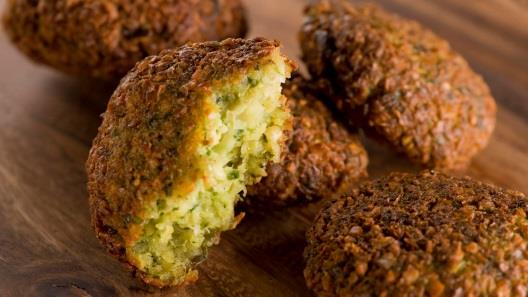
Ingredients (serves 6):
- 400g can of chickpeas (240g drained weight = 32g carbs)
- 1 small onion, finely chopped (0g)
- 1 garlic clove (0g)
- 1 teaspoon ground cumin (0g)
- 1 teaspoon ground coriander (0g)
- 1 teaspoon dried mixed herbs (0g)
- 1 egg, beaten (0g)
32g ÷ 6 = 5.3 = 5g per falafel
Method:
1. Fry the onion and garlic gently until softened
2. Add to a bowl with the chickpeas, herbs and spices and mash together with a fork or potato masher
3. Add the beaten egg and mix well
4. Shape the mixture into patties about the size of a golf ball and flatten. Chill for 15 mins
5. Fry until golden brown on each side (about 2-3 minutes per side)
6. These can be served in flat breads or pitta bread (carb count)with lots of crunchy salad or dipped into a spicy salsa (0g)
Savoury scones
Ingredients (makes 12 small scones):
- 200g self raising flour (160g)
- 50g spread (0g)
- 75g cheddar cheese (0g)
- 150ml milk (7.5g)
- 1 teaspoon mixed herbs (0g)
160g + 7.5g = 167.5g /167.5g ÷ 12 = 13.9 = 14g carbs per scone
Method:
1. Heat the oven to 200°C/Gas mark 7
2. Grate the cheese
3. Sieve the flour into a bowl
4. Add the spread to the flour and rub together to form breadcrumbs
5. Add the cheese and/or the herbs
6. Add 100mls of the milk and mix to form a dough. If the mixture is too dry, add the remaining milk.
7. Knead gently for a minute and then turn onto a floured surface. Roll or press into a disc no thinner than 2cm
8. Using a biscuit cutter, cut out discs. Reform the dough and repeat until you have used all the dough
9. Brush with milk and bake for about 10-15 mins until golden brown and the scones sound ‘hollow’ when tapped on the underneath.
10. Can be served with just spread or with ham, salad or slices of apple
Coleslaw
Ingredients:
- 1 large carrot (0g)
- ½ onion (if large) (0g)
- ¼ white or red cabbage (0g)
- Can add 1 clove crushed garlic (0g)
- 1 tablespoon low fat mayonnaise (or 2 if not using yoghurt) (0g)
- 1 tablespoon plain yoghurt (this is optional – it just makes the coleslaw lighter (0g)
0g carbs
Method:
1. Peel the carrot and grate
2. Either grate or finely shred the cabbage
3. Chop the onion very finely
4. If using garlic, crush or grate the clove
5. Mix all the ingredients together
6. Add the mayonnaise and/or yoghurt
7. Season and mix together well
Savoury carrot and courgette muffins
Ingredients:
- 100g wholemeal self raising flour (70g)
- 2 tablespoons milk (1.5g)
- 100g grated carrot (0g)
- 100g grated courgette (0g)
- 125g spread (preferably low fat), melted and cooled slightly (0g)
- 2 eggs, beaten (0g)
- 1 teaspoon mixed dried herbs (0g)
- 1 teaspoon baking powder (0g)
- 75g porridge oats (45.4g)
Total carbs 116.9g (70+1.5+45.4). 8 portions 116.9 ÷ 8 = 14.6g = 15g carbs per muffin
Method:
1. Preheat the oven to 180°C/ gas mark 4. Line a muffin tin with 8 muffin cases (or squares of greaseproof paper)
2. Mix together the cooled melted spread, milk and eggs. Stir in the grated carrot and courgette.
3. In a large separate bowl, combine the flour, baking powder, dried herbs and porridge oats.
4. Stir the wet ingredients into the dry ingredients until combined well but try not to overmix.
5. Spoon into the muffin cases and bake for 25-30 mins, until firm and golden.
Try adding 50g crumbled feta cheese and /or ¼ fresh chilli (finely chopped) or ¼ teaspoon chilli powder – Neither of these ingredients will affect the carb content.
(Taken from Change4Life recipes: https://www.nhs.uk/change4life/recipes )
Bhaji Frittata
Ingredients:
- 2 tablespoons vegetable oil
- 2 onions, thinly sliced
- 1 garlic clove, finely chopped/grated
- 2 teaspoons mild curry powder
- 450g potato, coarsely grated and any excess liquid squeezed out
- 6 medium eggs, beaten
- 100g frozen peas, defrosted
- ½ small pack coriander, roughly chopped
Method:
1. Heat oven to 200°C/180°C fan/gas 6. Heat the oil in an ovenproof frying pan and fry the onion for about 10 mins over a medium heat until golden. Add the garlic and curry powder and cook for 1-2 mins.
2. Next, add the grated potatoes and cook for 5-8 mins, stirring occasionally. You want the potatoes to soften, but also catch a little and turn golden in patches.
3. Season the eggs, then pour into the pan with the peas and most of the coriander, swirling to coat the potato mixture.
4. Cook for 1 min more, then transfer to the oven for 10 mins until the eggs have set.
Veg sticks and dips
Simply chop up your crunchy favourite vegetable to go with our dips below:
|
Guacamole (no cook)
Scoop the avocado flesh into a bowl. Squeeze the juice of 1 lime in and add the grated garlic. Season. Mash together with a masher or a fork and taste. It may need the juice from the other lime, if so, add that to suit your taste. Can add finely chopped chilli of you like it zingy! From the carbs and cals book 30g (2 tablespoons) = 1g carbs |
Tzatziki (no cook)
Add yoghurt to a bowl, grate in the cucumber and garlic. Season with black pepper. Mix together! Whole dip is 200g. 1 portion is 30g. Portions in recipe 200÷30g = 7 portions Total = 13g carbs. Carbs per 30g portion is 13g ÷7 = 2g carbs |
|
Minty pea dip (no cook)
Add to a bowl and blend with a handblender until smooth. If you want a chunkier dip, just blend less! Whole dip is 150g. 1 portion is 30g. Portions in recipe 150÷30g = 5 portions Total carbs = 13g ( using soured cream) 14.4g carbs (using natural yoghurt). Carbs per 30g portion 13g ÷5 = 2.6g (soured cream) Carbs per 30g portion 14.4g ÷5 = 3g (natural yoghurt) |
Roasted pepper dip (no cook)
Tip the peppers into a bowl, add the other ingredients and blend with a handblender until smooth Carbs per portion will depend on carbs in jar of red peppers |
|
Sweetcorn dip (no cook)
Tip the sweetcorn into a bowl. Add the soured cream or yoghurt, lime juice, garlic and salt and pepper. Blend until smooth or chunky. Once blended, add the finely chopped spring onion and chilli (if using) and mix together. Whole dip is 230g. 1 portion is 30g. Portions in recipe 230÷30g = 8 portions Total carbs = 29g ( using soured cream) 30.4g carbs (using natural yoghurt). Carbs per 30g portion 29g ÷8 = 3.5g (soured cream) Carbs per 30g portion 30.4g ÷8 = 4g (natural yoghurt) |
Butternut squash dip (no cook)
Roast the squash until the flesh is soft. Scrape out of the skin and weigh the portion into a bowl. Add all your other ingredients, and mash together with a masher or a fork. Whole dip is 295g. 1 portion is 30g. Portions in recipe 295÷30g = 10 portions Total carbs = 21g ( using soured cream) 22.4g carbs (using natural yoghurt). Carbs per 30g portion 21g ÷10 = 2g (soured cream) Carbs per 30g portion 22.4g ÷10 = 2.2g (natural yoghurt) |
Sweet scones
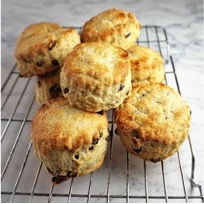
Ingredients:
- 200g self raising flour (160g)
- 50g spread (0g)
- 150ml milk (7.5g)
- 1 teaspoon xylitol/stevia (0g)
Added extras:
- 2 tablespoons dried fruit eg raisins (16g)
- 1 small apple, grated (5g)
Carbs per plain scone = 167.5g ÷ 12 = 13.9 = 14g
Carbs per raisin/cranberry scone = 167.5 + 16 = 183.5 = 15.2 = 15g
Carbs per apple scone = 167.5 + 5 = 172.5 = 14.3 = 14g
Method:
- Heat the oven to 200°C/Gas mark 7
- Sieve the flour into a bowl
- Add the spread to the flour and rub together to form breadcrumbs
- Add whatever extra ingredient you want here, eg raisins, cranberries, grated apple.
- Add 100mls of the milk and mix to form a dough. If the mixture is too dry, add the remaining milk.
- Knead gently for a minute and then turn onto a floured surface. Roll or press into a disc no thinner than 2cm
- Using a biscuit cutter, cut out discs. Reform the dough and repeat until you have used all the dough
- Brush with milk and bake for about 10-15 mins until golden brown and the scones sound ‘hollow’ when
- tapped on the underneath.
- Serve with spread
Lemon and raspberry cupcakes or loafcake
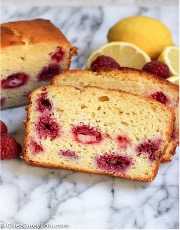
Ingredients:
- 50g SR flour (40g)
- 150g ground almonds (10g but we don’t need to count nuts)
- 1 teaspoon bicarbonate of soda
- 100g spread/butter (0g)
- 80g xylitol (40g)
- 150g raspberries (15g)
- 2 eggs (0g)
- Zest of 2 lemons (0g)
Total carbs 95g in the cake (40+40+15). 12 portions (either cupcake or slice of loaf cake) 95/12 = 8g carbs per cupcake/slice
Method:
- Line a loaf tin or cupcake tin
- Cream together the butter or spread and xylitol. Add the lemon zest.
- Sieve the SR flour and bicarbonate of soda together into the butter mixture
- Add the ground almonds
- Beat the eggs together and add to the dry ingredients
- Mix all the ingredients together. If the mixture is too dry, add a dash of milk to loosen
- Fold in the blueberries gently
- Either tip into a loaf tin or divide the mixture into the cupcake cases.
- Bake at 180°C (Gas mark 4). About 10-15 mins for the cupcakes or 25 – 30 mins for the loaf cake. Test with a skewer, if it comes out clean, the cake is done.
Healthier foods for breaking your Ramadan fast
If you are fasting and have diabetes, it is important to choose foods for your iftar meal that will cause a minimal rise in your blood glucose. This will help you to manage your diabetes better, making fasting more controllable and prevent feeling unwell due to high or low BG levels at a time when you wish to spend that time with family and friends.
The iftar meal marks the end of your fast and signals the time to replenish your body with energy and nutrients.
It is always best to drink water and unsweetened fluids rather than fruit juices and fizzy dinks which are high in sugar and are easily absorbed causing a spike in BG which can then be hard to bring down before your suhoor meal. Drinking plenty of fluids, as well as consuming fluid-rich foods, such as fruit, vegetables, yogurt, soups and stews, is very important to replace fluids lost during the day and to start the next day of fasting well hydrated.
Salt stimulates thirst and so it’s a good idea to avoid consuming a lot of salty foods. The pre-dawn meal, suhoor, provides fluids and energy for the day of fasting ahead, so making healthy choices can help you to cope better with the fast (see suggestions below).
While iftar meals are often a time for celebration, with families and friends coming together to break their fasts, it’s important not to go overboard when eating during Ramadan. Consuming a lot of deep fried, creamy and sweet foods may cause you to gain weight during Ramadan. Ramadan can be a good time to make changes to improve the balance of your diet that you can sustain in the longer term.
The changes to eating habits and lack of fluids during the day may cause constipation for some people. When you can eat and drink, consuming plenty of high fibre foods, such as wholegrains,fruit and vegetables, beans, lentils, dried fruit and nuts alongside plenty of fluids may help to ease constipation as well as doing some light physical activity, such as going for a walk after iftar.
Food and drink choices for Iftar
When first breaking the fast go for plenty of fluids, low fat, fluid-rich foods and foods containing some natural sugars for energy (avoid consuming a lot of foods or drinks with added sugars). Below are some examples:
- Drinks – water, milk, unsweetened lassi, sugar free options – water provides hydration without any extra calories or added sugars and is the best drink to break your fast with. Avoid: fruit juices, fizzy drinks as these will raise BG very high, making it difficult to manage.
- Dates – traditionally eaten to break the fast since the time of the Prophet Muhammad. Whilst dates contain natural sugar and fibre, 2 large dates can contain as much as 20g – 30g of carbohydrate and may cause a ‘spike’ in you BG levels. Other foods that may reduce this spike are nuts or other fruits eg berries, citrus fruits, grapefruit (watch with BP meds).
- If you are reluctant to break your fast with foods other than dates, add some almonds and try and have no more than 1 date.
- Fruit – a traditional way to break the fast in South Asian cultures, fruit provides natural sugars for energy, fluid and some vitamins and minerals.
- Soup – traditional in many Arab countries, is a light way to break the fast and provides fluid. Traditional soups are based on a meat broth and often contain pulses, like lentils and beans, and starchy foods like pasta or grains, providing nutrients and energy.
- After breaking the fast – meals vary between different cultures and traditions but try to make sure the foods you eat provide a balance. Following the food groups in the Eatwell Guide can help.
- Eating foods high in fibre first such as salad, veg sticks/crudites before your main meal may help to prevent your BG rising very high. Following these with your protein foods such as dhals, meat, chicken and fish and wholegrain carbohydrates, eg rice, roti, chapatti can help diabetes management and therefore how ell you feel throughout Ramadan.
- The iftar meal is a chance to celebrate with family and friends. However, try to keep the amount of fried and sugary foods to a minimum. You only have a relatively short time each day to eat and drink to provide your body with all the essential nutrients and fluids it needs to be healthy, so the quality of your diet is especially important during Ramadan.
Ideally, once you have had a chance to digest your food, some light exercise such as going for a walk is beneficial for helping to manage BG. If you attend Taraweeh prayers (special night-time prayers for Ramadan) in the evening, perhaps you could walk all or part of the way there.
Food and drink choices for Suhoor
Drink plenty of fluids, choose fluid-rich foods to make sure you are well hydrated for the day ahead and go for starchy foods for energy, choosing high fibre or wholegrain varieties where possible as these can help keep you feeling fuller and can aid digestion, helping to prevent constipation. Below are some examples:
- Oats - these are wholegrains, and you could choose porridge, which will also provide fluids as it’s made with milk or water, muesli with milk or yogurt or overnight oats. You could experiment with fresh or dried fruit, nuts or seeds as toppings.
- Starchy foods like rice, or couscous – you could try a low sugar rice pudding with fruit or experiment with couscous or other grains with dairy or fruit. If you go for savoury dishes at suhoor then it's a good idea to make sure these are not too salty, or they may make you very thirsty during the fast.
- Yogurt – this can be a good food to include at suhoor as it provides nutrients like protein, calcium, iodine and B vitamins and contains fluid. You could combine it with wholegrains, nuts and fruits, eg berries.
- Breads – go for wholegrain options as these provide more fibre, for example wholemeal toast or chapattis. Avoid combining bread with salty foods like hard cheese, or preserved meats. You could try nut butters (without added salt or sugar – 100% nuts), soft cheese, or banana.
- Avocado, eggs, tomatoes, lentil soup, lightly spiced dhals and fish are all good choices for suhoor and will help stabilise BG levels throughout the day as well as keeping you fuller for longer.
Find more information on the Diabetes UK website and the International Diabetes Federation website.
Health issues during Ramadan
During Ramadan, there is a dramatic change in dietary patterns for fasting Muslims compared with other months of the year. Health issues may arise due to the change in eating habits and reduced physical activity. Unhealthy patterns that are common during Ramadan include:
- Eating particularly large meals at iftar (consuming more than 1500 calories per meal), which may result in high blood glucose levels after eating and weight gain.
- Eating significant amounts of highly processed carbohydrates (bagels, panini) and sugar at iftar, or between iftar and suhoor, which may also cause severe high blood glucose levels.
- Eating desserts loaded with sugar after iftar, which can lead to raised blood glucose levels after meals.
- Having a lot of large snacks between the two main meals, which can contribute to longer periods of high glucose levels.
- Eating at a fast speed, which commonly leads to over-eating.
- Eating suhoor early, which may result in hypoglycaemia before iftar, especially when fasting hours are longer than usual
- Eating large portions of high glycaemic index (GI) carbohydrates at suhoor, which can lead to high blood glucose levels after meals.
- Frying food, which is particularly unhealthy, especially when using trans-fat margarine or oils rich in saturated fat (e.g. ghee)
- Changes in physical activity and sleeping patterns can affect metabolism and may lead to weight gain.
Managing Ramadan for type 1 diabetes (whilst taking insulin)
If you are overweight, you may lose weight during Ramadan, which will help you improve the way you control your blood glucose levels. The following tips will be helpful:
- Divide your daily food into two meals, Sehri and Iftar.
- Have some starchy food such as cereals, basmati rice, chapatis or naan at every meal.
- Have plenty of fruit, vegetables, dhal and yoghurt.
- Avoid sweet foods such as ladoo, jalebi or burfi.
- Avoid fatty fried foods such as samosa or pakora.
- Stick to low-calorie or ‘diet’ drinks or, better still, water. Drink plenty of fluid.
You may feel tired when fasting during Ramadan, so although it is important that you continue your daily activity and prayer, try to rest at some point in the day.
If you manage your diabetes with insulin, it is vital that you know what to do when fasting to avoid hyperglycaemia (more than 10) or hypoglycaemia (less than 4). You
must check your blood glucose frequently to make sure that it is staying within a normal range.
In general, you will need much less insulin when you are fasting and will need more during the hours when you are eating. If you do not adjust your insulin regime you will be at risk of hypoglycaemia during fasting hours.
Some Safety Tips
- Always carry glucose treatment with you.
- Always have diabetes identification, such as a medical bracelet.
- Test your blood regularly to monitor your glucose levels. This will not break your fast.
- Test your blood glucose level if you feel unwell during the fast.
- If your blood glucose level is high or low, you must treat this.
- If your blood glucose is less than 4 mmol/L, end the fast immediately and treat the low blood glucose level.
- If your blood glucose level is 4 mmol/L at the start of the fast and you take insulin or gliclazide, do not fast.
- If your blood glucose level is higher than 16 mmol/L, end the fast immediately. If you take insulin, you may need to take a corrective dose. If they remain high, contact your diabetes team
- If you become dehydrated, end the fast immediately and have a drink of water.
- If you start to feel unwell, disoriented, confused, if you collapse or faint, stop fasting and have a drink of water or other fluid.
- You should never stop your insulin, but you must speak to your doctor or diabetes team because you may need to change the dose and times of your insulin injections.
- If you have to break your fast for any reason, continue your meals as normal for that day
Summary
- Speak to your healthcare team if you are planning to fast.
- If you test your blood glucose levels at home check your levels more often.
- Continue a varied and balanced diet.
- Include more slowly absorbed foods that will not cause sharp rises in your blood glucose
- Try not to have too many sugary and fatty foods.
- When you break the fast, ensure you drink plenty of sugar-free and decaffeinated drinks to avoid dehydration.
https://www.diabetes.org.uk/guide-to-diabetes/managing-your-diabetes/ramadan
Pancake Day, or Shrove Tuesday, is the traditional feast day before the start of Lent on Ash Wednesday.
The word ‘Shrove’ comes from the word ‘shrive’ which means to give absolution for sins following confession. This is observed in many Christian countries to prepare for Lent – the 40 days leading up to Easter – which was traditionally a time of fasting.
Why do we eat pancakes on Shrove Tuesday?
It was the last chance for a spot of indulgence before 40 days of fasting, and also an opportunity to use up food that couldn’t be eaten during Lent. This included eggs, fat and milk, which were made into pancakes and eaten on that day.
The earliest known English recipe dates from the 15th century, although pancakes had been eaten in other countries for centuries before that. In French speaking countries, the day is known as ‘Mardi Gras’ or ‘Fat Tuesday’.
Basic pancake recipe
Ingredients:
- 100g plain flour (81g)
- 2 eggs (0g)
- 300ml semi-skimmed milk (15g)
- vegetable oil for frying (0g)
- pinch salt
Method:
1. Put 100g plain flour and a pinch of salt into a large mixing bowl.
2. Make a well in the centre and crack 2 eggs into the middle.
3. Add the milk gradually, whisking in a steady stream of the milk. Continue pouring and whisking until you have a batter that is the consistency of slightly thick single cream.
4. Heat the pan over a moderate heat, then wipe it with oiled kitchen paper.
5. Ladle some batter into the pan, tilting the pan to move the mixture around for a thin and even layer. Quickly pour any excess batter into the mixing bowl, return the pan to the heat.
6. Leave to cook, undisturbed, for about 30 secs. If the pan is the right temperature, the pancake should turn golden underneath after about 30 secs and will be ready to turn.
7. Hold the pan handle, ease a palette knife under the pancake, then quickly lift and flip it over. Make sure the pancake is lying flat against the base of the pan with no folds, then cook for another 30 secs before turning out onto a warm plate.
8. Continue with the rest of the batter, serving them as you cook or stack onto a plate. You can freeze the pancakes for 1 month, wrapped in cling film or make them up to a day ahead.
Total carbs = 81 + 15 = 96g
Makes about 10 pancakes so approx. 10g per pancake (+ toppings)
Gluten-free pancake recipe
Ingredients:
- 125g gluten-free plain flour (100g)
- 2 eggs (0g)
- 250ml milk (12.5g)
- Vegetable oil for frying
Method:
Same as for regular pancakes above
Total carbs 100 +12.5 = 112.5g
Makes about 10 pancakes so approx. 11g per pancake (+ toppings)
SAVOURY TOPPINGS
- Garlic mushrooms (0g)
- Creamy mushrooms (0g)
- Chicken and mushroom (0g)
- Savoury mince/chilli (0g)
- Ham and cheese (0g)
- Spinach and feta or spinach and ricotta (0g)
SWEET TOPPINGS
- Maple Syrup. (5g carbs per teaspoon)
- Fresh Fruit/frozen berries (weigh and carb count)
- Whipped Cream (0g carbs)
- Squirty Cream (carb count)
- Bananas and dark chocolate chips (weigh and carb count)
- Chocolate spread (Meridian is best as it does not need to be carb counted. Nutella definitely does!)
- Nuts (0g carbs)
- Sugar and lemon (5g carbs per teaspoon)
For more information and recipes, visit:
Chocolate orange souffle
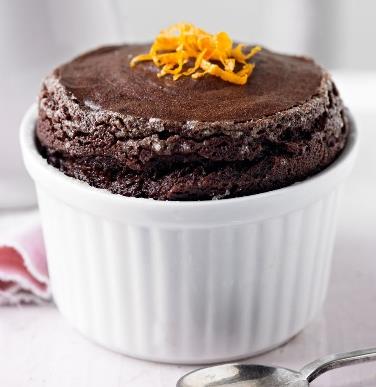
Ingredients: (makes 2)
- A little spread, for greasing (0g)
- Grated rind and juice of 1 large orange (15g)
- 25g xylitol (13g)
- 2 large egg whites, beaten until stiff (0g)
- 15g unsweetened cocoa powder, plus extra for dusting (0g)
- Few drops of orange extract (available from all good supermarkets but optional) (0g)
- Crème fraiche to serve (0g)
Method
1. Preheat oven to 200°C/fan 180°C/gas 6.
2. Lightly grease 2 ovenproof teacups or ramekin dishes. Dust with cocoa powder
3. In a small pan, heat the orange rind, juice and xylitol for 3–4 minutes until syrupy. Pour the syrup over the egg whites and beat for 2 minutes until you get stiff peaks.
4. Fold in the cocoa and orange extract (if using), then pour into the teacups.
5. Cook in the oven for 5–6 minutes or until risen. Dust with cocoa powder
6. Serve with the crème fraîche.
Total carbs – 13g + 15g = 28g
Carbs per portion 28g ÷ 2 = 14g per souffle
Recipe tips
- If you have trouble getting your egg whites to peak properly, add a drop or two of lemon juice to help strengthen the structure of the mixture.
- To get your soufflés to rise, don’t overfold. Instead, gently fold in the whites until the point where the streaks of white disappear.
- Use fresh, room temperature eggs. Whipping cold eggs is harder work and you won't get as much lift from them.
Fruity choc pops

- 100g 70% dark chocolate (34g)
- Fruit of your choice chopped into bite sized pieces
- Chopped nuts (toasted in the oven for a few minutes) - optional (0g)
- Lolly sticks
Method:
1. Toast the nuts (don’t leave them, they toast quickly!) and lay over greaseproof paper
2. Melt the chocolate and place a dessertspoon of melted chocolate onto the toasted nuts – you should get 6 ‘pops’. Insert your lolly stick
3. Place your fruit on top of the soft chocolate
4. Place in fridge to firm
5. Peel off the greaseproof paper and serve
Per fruit pop = 6g carbs + carbs for fruit
Chocolate truffles
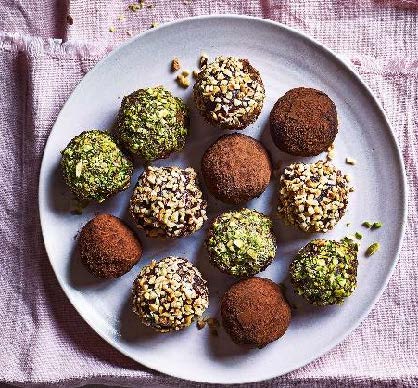
Ingredients: (makes 12)
- 100g 70% Lindt dark chocolate (34g)
- 1 small teaspoon of set honey (5g)
- 150ml double or whipping cream (0g)
- 50g unsweetened cocoa powder/chopped nuts/desiccated coconut (for rolling your truffles in at the end) (0g)
1. Heat the cream (do not boil). Take off the heat and add chocolate to melt into the warm cream. Add the teaspoon of honey
2. Place in a bowl and place in the fridge until firm. Use a teaspoon to scoop 12 walnut sized truffles. Roll the truffles into a bowl and then a coating of your choice
3. If you are using chopped nuts and/or coconut to coat your truffles, toast them gently in a dry frying pan to give a fuller flavour. They do not take long to toast so keep them moving and don’t leave the pan or they will burn quickly.
4. Once coated, refrigerate to keep the truffles firm (and to keep the cream fresh)
Alternatives:
- You could push a whole hazelnut or almond into the centre of the truffle (0g carbs). Roll in coating as above
- Add orange zest from 1 orange, ¼ teaspoon peppermint extract or coffee extract at point 1) for orange chocolate, mint and coffee chocolate truffles. Roll in coating of your choice, eg hazelnuts, pistachios, coconut etc
- •ou can also add a large pinch of cinnamon powder or mixed spice to the cocoa powder
Total carbs = 39g. 39 ÷ 12 = 3.25g = 3g carbs per truffle



